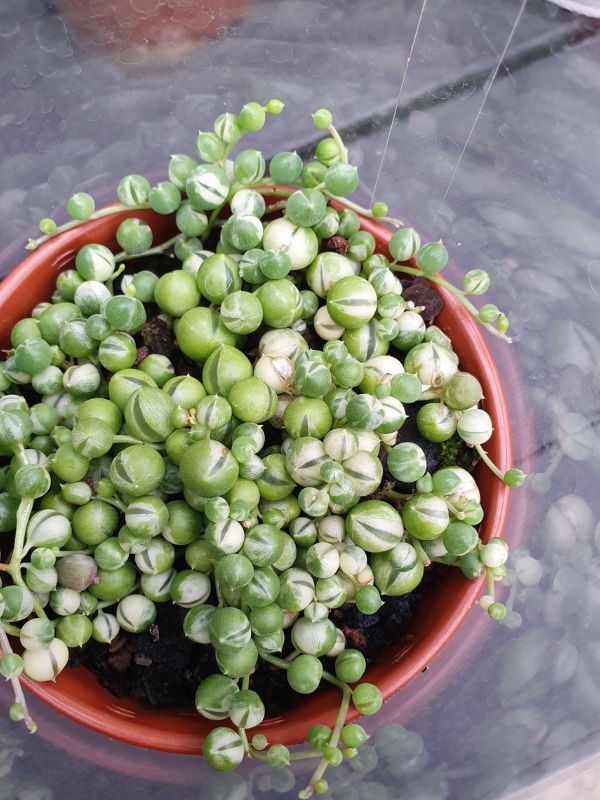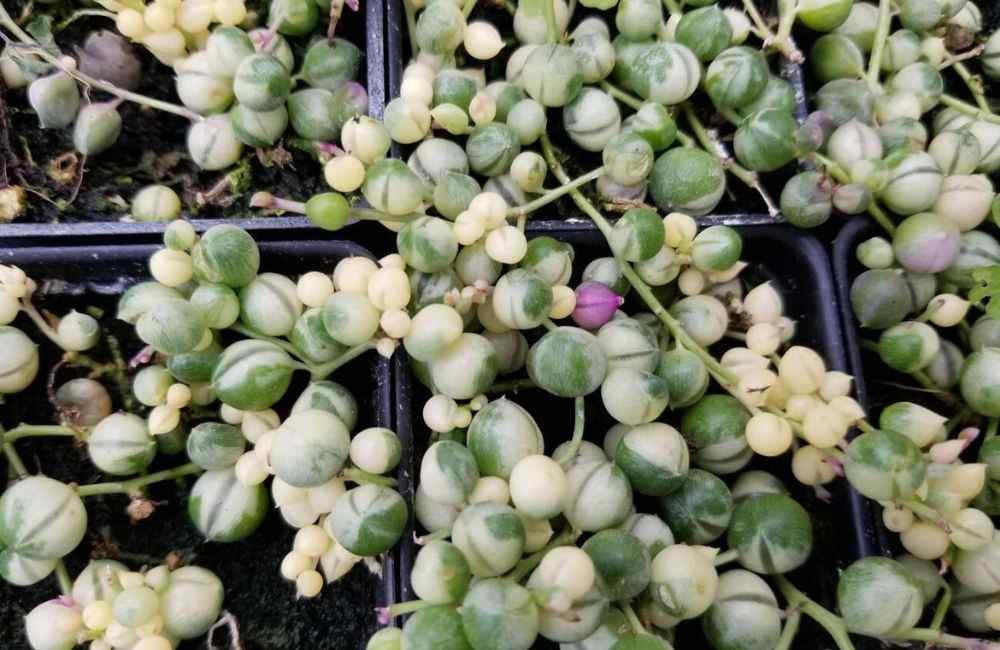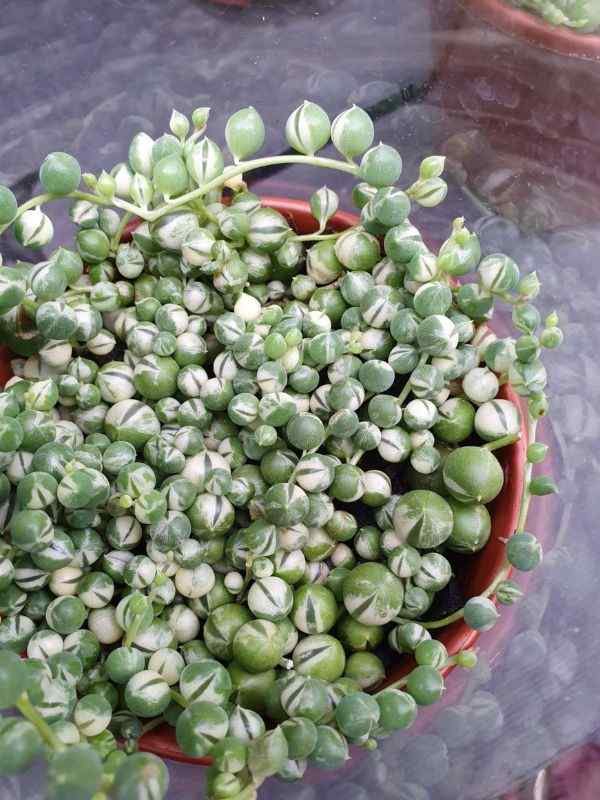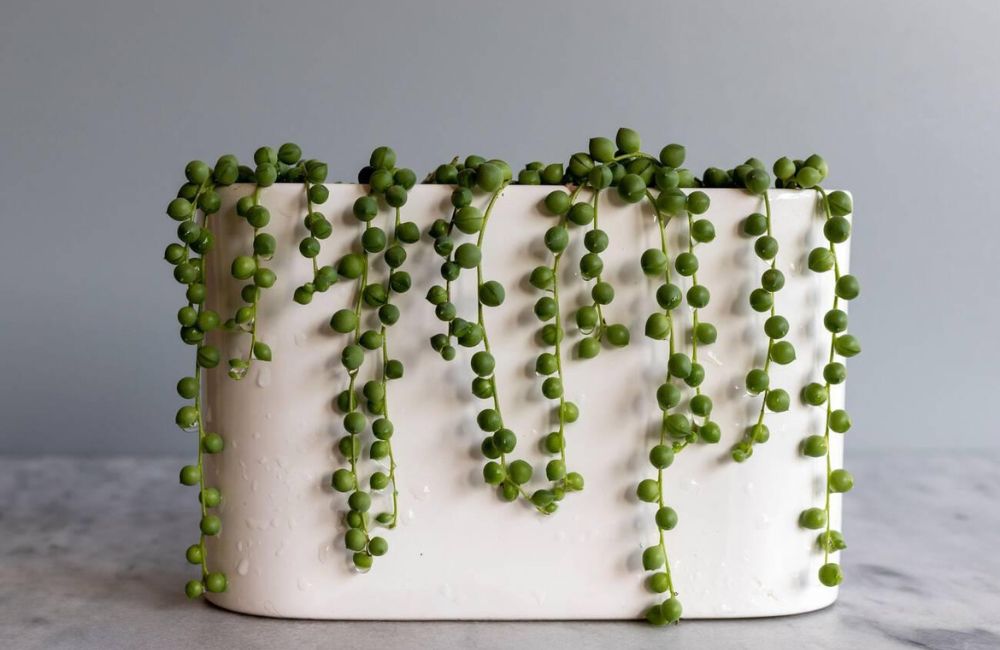The variegated string of pearls is a mesmerizing plant that will captivate your attention. With its unique appearance and delicate beauty, this plant has become popular among plant enthusiasts and interior decorators. Whether you’re already familiar with this stunning succulent or just discovering its allure, prepare to be enchanted by the variegated string of pearls.
In this blog, we will explore the various aspects of this plant, from its care requirements to its versatility in home decor. So, get ready to dive into the world of the string of pearls variegated and uncover the secrets behind its charm.
What Is Variegated String of Pearls?

Variegated String of Pearls, also known as Senecio rowleyanus ‘Variegatus,’ is a popular succulent plant with unique trailing vines resembling pearl strings. This charming plant features small, round leaves that are variegated with green and creamy white colors, adding a touch of elegance to any indoor or outdoor space. With its drought-tolerant nature and low-maintenance requirements, the Variegated String of Pearl is perfect for beginners and busy plant enthusiasts. Whether displayed in a hanging basket or as a cascading accent in a pot, this delightful succulent will surely be a conversation starter in any plant collection.
SPECIFICATIONS
Botanical Name: Senecio rowleyanus (Variegated String of Pearls)
Common Names: Variegated String of Pearls, Variegated Bead Plant
Product Size: 3.5″
Color-Primary: White
Color- Secondary: Green / Lime, Pink
Bloom Color: White Bloom
Cold Hardiness: Zone 10 (30F)
Recommended light conditions: Filtered / Partial Sun, Bright Indoor Light
Maximum height: Over 12″
Growth habit/size: Hanging / Trailing
seasonality: Summer Dormant Partial
Special features: Showy Blooms, Easy to Propagate, Variegated
Toxicity: Toxic to pets and animals.
Variegated String of Pearls vs String of Pearls
There are distinct differences when comparing the Variegated String of Pearls with the String of Pearls. The Variegated String of Pearls, also known as Senecio rowleyanus ‘Variegatus,’ features captivating variegated leaves with shades of green, cream, and sometimes pink.
On the other hand, the String of Pearls, scientifically known as Senecio Rowleyanus, showcases lush green spherical leaves resembling beads.
Both varieties are popular for indoor gardening enthusiasts, but the Variegated String of Pearls adds an extra touch of uniqueness with its striking variegation. Whether you prefer the classic greenery of the String of Pearls or the eye-catching variegation of the Variegated String of Pearls, both plants will surely bring charm and elegance to any space.
Variegated String of Pearls Care

Now that you’re intrigued by the string of pearls variegated, let’s explore how to care for this lovely succulent.
How much light does a variegated string of pearls need?
This succulent thrives in bright, indirect light. Place it near a window where it will receive plenty of sunlight, but protect it from direct, intense sunlight, as it can scorch the leaves.
What is the best soil for a variegated string of pearls?
As a succulent, it is more tolerant of dry soil than wet soil during the growing season and winter months. Mix 25% pumice and/or perlite with the soil to keep it well-drained and aerated. To prevent waterlogging, choose a pot with drainage holes.
How often should I water a string of pearls?
As a succulent, the variegated string of pearls stores water in its leaves, making it drought-tolerant. Allow the soil to dry between waterings, then water the plant sparingly. It is crucial to find the right balance between overwatering and underwatering in order to avoid root rot.
Temperature

Variegated String of Pearls prefers moderate to warm temperatures, similar to what you’d find in its native habitat of South Africa. Keep your Variegated String of Pearls in a range between 70°F to 80°F (21°C to 27°C) during the daytime.
During the winter months, when the plant is in its semi-dormant phase, it can tolerate slightly cooler temperatures, but try not to expose it to temperatures below 50°F (10°C).
Protect your plant from extreme heat, as temperatures above 90°F (32°C) can stress and damage it. If you’re in a very hot climate, provide filtered sunlight or partial shade.
Humidity

These succulents can tolerate normal indoor humidity levels, which typically range from 30% to 50%. They are not as sensitive to humidity as some other plants.
Adequate air circulation is important to prevent moisture buildup on the leaves, which can lead to rot. Ensure the room has some airflow, especially if you’re growing the plant indoors.
While they don’t require high humidity, Variegated String of Pearls should also be shielded from excessively dry conditions, which can cause the leaves to shrivel.
Misting is generally not necessary and can lead to overwatering. If you live in a very dry climate, consider using a humidity tray or a room humidifier to increase moisture in the air.
What is the best fertilizer for a string of pearls?
When it comes to nurturing your delicate string of pearls, finding the right fertilizer is essential for their lustrous growth. These whimsical succulents thrive when given a balanced liquid fertilizer diluted to half its recommended strength. Look for a fertilizer with an N-P-K ratio of 20-20-20, ensuring a healthy dose of essential nutrients. During the growing season, typically spring and summer, feed your string of pearls every four to six weeks. Remember, moderation is key, as over-fertilizing can lead to salt build-up and harm your precious pearls. So, please treat them with care and watch your little green treasures flourish.
The variegated string of pearls does not require much fertilizer. A balanced fertilizer can encourage new growth. Feed your plants with a balanced liquid succulent fertilizer every 4-6 weeks during the growing season (spring and summer).
Pruning and Maintenance
When it comes to a variegated string of pearls pruning and maintenance, it is important to follow a few key steps to ensure the health and beauty of your plant. Regular pruning is essential for controlling the growth and maintaining the desired shape. Start by removing any dead or damaged strands, and cutting them back to the base of the plant. To encourage fuller growth, pinch off the tips of the stems, promoting branching. Additionally, it is crucial to provide proper watering and light conditions for the variegated string of pearls to thrive. Following these simple practices, you can keep your variegated string of pearls looking vibrant and lush.
Repotting Your Variegated String of Pearls
Repotting your variegated string of pearl is essential to ensure its healthy growth and longevity. When repotting your plant, choosing the right potting mix that provides good drainage and aeration for the roots is important. Start by gently removing the plant from its current pot, careful not to damage the delicate pearl-like leaves.
Then, please place it in a slightly larger pot and fill the gaps with fresh potting mix, making sure to firm it gently around the roots. Finally, give your variegated string of pearls a thorough watering and place it in a bright location with indirect sunlight. Following these steps, you’ll go to a thriving and vibrant variegated string of pearls.
Variegated String of Pearls Propagation
Are you interested in expanding your Variegated String of Pearls collection? Propagating this unique and stunning plant is a straightforward process that can be done in various ways. Here are three propagation methods for Variegated String of Pearl, which you can choose from based on your preference.
Stem Cuttings
- Dry a plant stem for one or two days.
- Insert the stem into well-draining potting soil by placing it about an inch deep.
- Once planted, water it to keep the soil moist.
- After a few weeks, you’ll see new growth emerging from the stem, signaling that the propagation was successful.
Water Propagation
With this method, cut a healthy stem from your Variegated String of Pearls and submerge the cut end into a freshwater jar, ensuring the stem is not fully submerged. Keep the jar in a well-lit spot, but avoid direct sunlight. Change the water regularly, every few days, and mist the stem with water periodically. After a few weeks, roots will grow, and you can transfer the plant into the soil.
Leaf Cuttings
- Remove a healthy leaf from your plant from the stem, ensuring it remains intact.
- Allow the cutting to dry for a day, then plant it in well-draining soil.
- Water the cutting lightly and place it in a warm, bright location but away from direct sunlight.
- After a few weeks, roots will form, and the plant will grow new leaves.
Note: Remember that it may take some time for newly propagated plants to grow and mature, so be patient and provide proper care.
Variegated String of Pearls Care by Season
Variegated String of Pearls care by season is crucial to keep this unique succulent thriving all year round. Understanding the specific needs of this plant during different seasons can help you provide the best care possible. During the spring and summer months, ensure your string of pearls variegated receives bright, indirect sunlight and water it thoroughly, allowing the soil to dry out between waterings.
In the fall and winter, reduce watering frequency and move the plant to an area with less light as it enters a period of dormancy. By following these seasonal care tips, you can enjoy the beauty of your Variegated String of Pearl throughout the year.
Benefits of Growing a Variegated String of Pearls
Growing a variegated string of pearls benefits indoor and outdoor spaces. The unique variegation of the leaves adds a touch of elegance and beauty to any setting. These plants are known for their low maintenance requirements, making them perfect for busy individuals or those lacking a green thumb. The pink variegated string of pearls is also an excellent choice for purifying the air, as it helps remove toxins and improve the overall air quality. With their trailing nature, these plants are ideal for hanging baskets or as a ground cover, creating a stunning visual display. Experience the benefits of growing a variegated string of pearls and enhance the ambiance of your living spaces.
Pests and Diseases
String of variegated pearls (Senecio rowleyanus) can be susceptible to a few common pests and diseases. The following is a guide to identifying, preventing, and treating them:
Pests
- Mealybugs: Mealybugs are insect pests that infest the leaves and stems of plants. Yellowing and wilting result from their feeding on the plant’s sap. To treat mealybugs, remove them manually with a cotton swab dipped in rubbing alcohol or use neem oil. To prevent the infestation from spreading, isolate the affected plant.
- Aphids: Aphids are tiny, soft-bodied insects that cluster on the plant’s new growth and leaves, sucking sap and causing distortion. You can dislodge them with a strong stream of water or use insecticidal soap. Aphid populations can be controlled by ladybugs, which are natural predators.
- Scale Insects: Scale insects appear as small, waxy bumps on the plant’s leaves and stems. Yellowing and wilting can result from their feeding on plant juices. Remove them manually with a soft brush or use neem oil.
- Spider Mites: Spider mites are tiny pests that spin webs and feed on plant sap, leading to stippling and discoloration of leaves. Increase humidity around the plant by misting it regularly to discourage spider mites. You can also use insecticidal soap to control infestations.
Diseases
- Root Rot: Root rot is a common issue in succulents, including variegated string of pearls, caused by overwatering or poorly draining soil. To prevent root rot, ensure your plant is in well-draining soil and allow the soil to dry out between waterings. If you suspect root rot, trim away affected roots, let the plant dry out, and repot it in fresh soil.
- Leaf Rot: Leaf rot can occur due to excessive moisture or poor air circulation. Remove any affected leaves promptly and adjust your watering habits to avoid prolonged dampness on the foliage.
- Powdery Mildew: Powdery mildew appears white and powdery on the leaves. It thrives in humid conditions. Avoid overhead watering by improving air circulation around the plant. Fungicidal sprays can be used to treat severe cases.
- Fungal Diseases: Other fungal diseases may affect a string of pearls variegated if conditions are too moist. Ensure the plant is in well-draining soil and avoid overcrowding pots. Remove affected areas and treat them with a suitable fungicide.
Note: To prevent pests and diseases, maintain proper care practices for your variegated string of pearls, including adequate lighting, well-draining soil, and careful watering.
Frequently Asked Questions (FAQs)
Are variegated strings of pearls rare?
Yes, variegated strings of pearls are considered rare. The variegation refers to different colors or patterns on the leaves, which sets them apart from the typical string of pearl plants. Due to their unique and eye-catching appearance, variegated strings of pearls are highly sought after by plant enthusiasts and collectors. Their rarity makes them a prized addition to any indoor garden or plant collection.
Can I Buy a variegated string of pearls?
Yes, you can buy a variegated string of pearls. You can purchase them in several places, including local plant nurseries, online plant stores, and even through social media platforms where plant enthusiasts trade or sell plants. Research and find a reputable seller to ensure you get a healthy and high-quality plant.
How much sun does a variegated string of pearls need?
The variegated string of pearl plants requires bright, indirect sunlight for optimal growth. Place them where they will receive four to six hours of bright, indirect sunlight per day. Intense sunlight can burn the leaves, so place them away from direct sunlight. If your plant is not getting enough light, you may notice the variegation on the leaves fading or the plant becoming leggy.
How fast does a variegated string of pearls grow?
Variegated string of pearls (Senecio rowleyanus) typically have a moderate growth rate. Their annual growth can reach 2-4 inches under ideal conditions. Light, temperature, and the way the plant is cared for can all affect the growth rate. Providing adequate sunlight, well-draining soil, and regular watering can promote healthy growth for a variegated string of pearls.
Why is my variegated string of pearls dying?
There could be several reasons why your variegated string of pearls plant is dying. One possible reason is improper watering. Variegated string of pearls plants are succulents and require well-draining soil. Overwatering can lead to root rot and, ultimately, the death of the plant. On the other hand, underwatering can cause the leaves to wither and turn brown.
Another potential reason for its decline could be insufficient light. It is possible for them to become weak and prone to disease if they don’t get enough light. They do not tolerate sudden temperature changes well and prefer temperatures between 60-80°F (15-27°C). Ensure it receives enough bright, indirect sunlight and avoid exposure to extreme temperature fluctuations or drafts.
Is the variegated string of pearls toxic?
Yes, the variegated string of pearls (Senecio rowleyanus ‘Variegatus’) is considered toxic to humans and pets. The plant’s leaves resemble beads, which pets may find tempting to chew on. If ingested, it can cause gastrointestinal upset, including vomiting and diarrhea. Contact with the plant sap may cause skin irritation or allergic reactions in humans. It is always important to keep plants known to be toxic out of reach of children and pets to ensure their safety.
Can a string of pearls be variegated?
Yes, A string of pearls (Senecio rowleyanus) can sometimes exhibit variegation. Variegation refers to the presence of different colors or patterns on the leaves of a plant. While the string of pearls is typically known for its round, green, beads-like leaves, some specimens may develop variegated foliage.
How do you care for a string of pearls variegated?
Caring for a string of pearls variegated plant is relatively easy, as long as you provide it with the right conditions. This succulent plant thrives in bright indirect light, so placing it near a window with filtered sunlight is ideal. However, direct sunlight can scorch its delicate leaves, so be cautious.
When watering, the string of pearls variegated prefers to dry out between waterings. Overwatering can lead to root rot and other issues, so letting the soil dry out is important before giving it another drink. With proper lighting, watering, and temperature conditions, your variegated pearls should thrive and add a beautiful touch to your indoor space.
What colors are variegated strings of pearls?
The variegated string of pearls, also known as Senecio rowleyanus, is a popular trailing succulent plant with unique bead-like leaves. The colors of variegated string of pearls can vary depending on the cultivar and growing conditions. Pearl strings with variegated leaves usually have stripes or markings of white or cream color. Some cultivars may have more pronounced variegation, while others may have a more subtle color pattern.
Do strings of pearls like direct sunlight?
While the string of pearls requires bright light to grow well, it should be protected from direct sunlight to prevent leaf damage. Providing it with bright, indirect light will help ensure its health and longevity.
How do you make a string of pearls grow faster?
To encourage faster growth in your string of pearls plant, there are a few key factors to consider. First and foremost, make sure your plant is receiving adequate sunlight. The string of pearl plants thrive in bright, indirect light, so placing them near a window with filtered sunlight is ideal. Temperatures between 60°F and 85°F (15°C and 29°C) are ideal for optimizing plant growth.
A string of pearls must be grown in soil that drains well. Use a succulent or cactus potting mix that allows excess water to drain away easily. This will prevent the roots from sitting in soggy soil and promote better growth.
Conclusion
We hope you enjoyed our blog post on the variegated string of pearls plant. Any plant enthusiast will love this unique and beautiful succulent. Whether you’re a seasoned plant lover or just starting, the variegated string of pearls will surely add elegance to your indoor or outdoor space. With its trailing stems and delicate, pearl-like leaves, this plant is visually stunning and relatively easy to care for. Remember to provide it with bright, indirect light and well-draining soil, and watch it thrive. If you want to add a touch of greenery to your home or office, consider adding the variegated string of pearls to your collection. Happy gardening!
You may also like-







